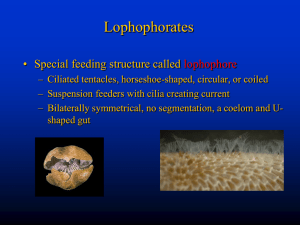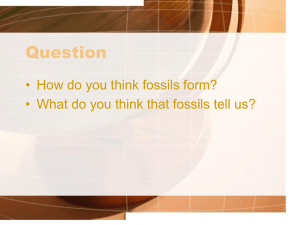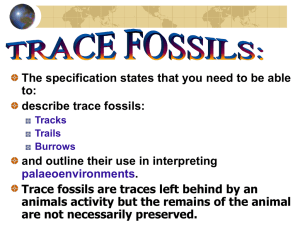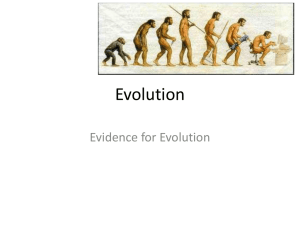Water vascular system
advertisement
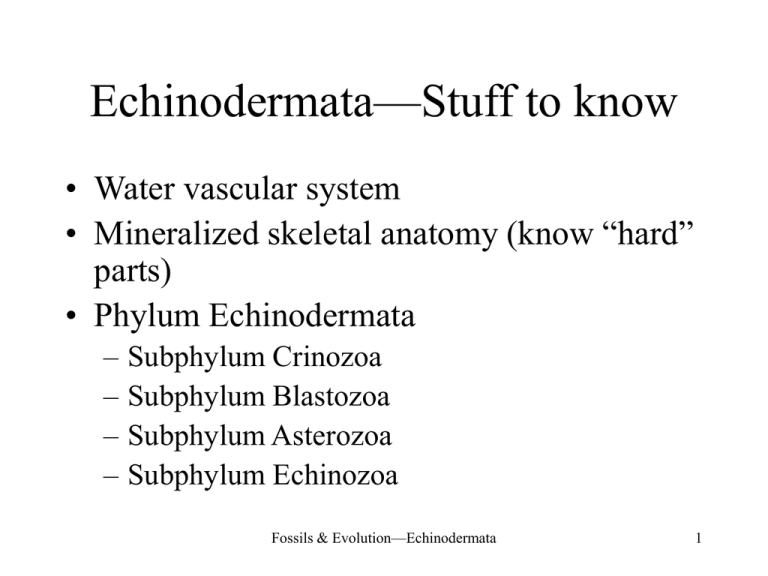
Echinodermata—Stuff to know • Water vascular system • Mineralized skeletal anatomy (know “hard” parts) • Phylum Echinodermata – – – – Subphylum Crinozoa Subphylum Blastozoa Subphylum Asterozoa Subphylum Echinozoa Fossils & Evolution—Echinodermata 1 Echinodermata—Phylum overview • • • • • • • • Deuterostomes Pentameral (five-fold) symmetry Internal skeleton made of ossicles or plates Each arm with ambulacral groove for collecting food Water vascular system (including tube feet) Rough, spiny epidermis Exclusively aquatic and marine Late Proterozoic–Holocene Fossils & Evolution—Echinodermata 2 Soft anatomy • Digestive system is usually one-way, with mouth, digestive glands, and anus – Brittle stars and some starfish lack anus • Food particles may be transported to mouth along ambulacral groove Fossils & Evolution—Echinodermata 3 Digestive system Fossils & Evolution—Echinodermata 4 Soft anatomy • Water vascular system provides structural support and assists in feeding, respiration, locomotion and sensory perception – – – – – – Circumoral ring Stone canal Hydropore (madreporite) Radial canal Tube feet Ampullae Fossils & Evolution—Echinodermata 5 Water vascular system Fossils & Evolution—Echinodermata 6 Skeleton • Skeleton is secreted by mesodermal layer and is therefore internal • Two main skeletal types – Theca (= calyx, test or disk) is a boxlike or saclike enclosure made up of sutured or imbricated plates (ossicles) • Ossicles are single high-Mg calcite crystals; highly porous – Loose sclerites are formed within the mesoderm for strength and support Fossils & Evolution—Echinodermata 7 Skeleton SEM view of highly porous ossicle Fossils & Evolution—Echinodermata 8 Skeleton (cont.) • Appendages include: – Spines for protection – Arms and brachioles for gathering food • Arms are radial extensions of body with ambulacral grooves and tube feet (e.g., in crinoids) • Brachioles are food gathering appendages mounted on recumbent ambulacral areas (e.g., in blastoids) – Stems and holdfasts for attachment Fossils & Evolution—Echinodermata 9 Skeleton (cont.) Echinoderm with recumbent ambulacral areas (no arms)—and four-fold symmetry brachioles Fossils & Evolution—Echinodermata 10 Crinoid structural units of stem are columnals Fossils & Evolution—Echinodermata 11 Classification Phylum Echinodermata Proterozoic–Holocene Subphylum Crinozoa Cambrian–Holocene Subphylum Blastozoa Cambrian–Permian Subphylum Asterozoa Ordovician–Holocene Subphylum Echinozoa Cambrian–Holocene asteroids (starfish) echinoids (sea urchins) ophiuroids (brittle stars) holothurians (sea cucumbers) Subphylum Homalozoa Cambrian–Devonian (relatively unimportant) [don’t worry about grey boxes] Fossils & Evolution—Echinodermata 12 Other points of interest • Echinoderms are deuterostomes – Style of larval coelomic development that links the phylum with hemichordates and chordates • Capable of regenerating lost appendages and even internal organs – Disaggregated occicles may contain live cells up to one year after becoming sedimentary grains Fossils & Evolution—Echinodermata 13 Ways of life • Many Paleozoic forms were attached, epifaunal suspension feeders – Paleozoic seas characterized by high primary productivity and relatively inefficient predators – Suspension feeders characterized by compact theca and well developed arms/brachioles • Mesozoic/Cenozoic forms are mostly infaunal detritus feeders and heavily armored carnivores – Possibly in response to decrease in primary productivity, increase in burrowing activity, and increase in efficiency of predators (especially fish) Fossils & Evolution—Echinodermata 14 Subphylum Crinozoa • Globular, tightly sutured calyx • Long arms, often with pinnules • Mouth in center of upper surface; anus lateral • Mostly without hydropore • Mostly attached suspension feeders Fossils & Evolution—Echinodermata 15 Subphylum Blastozoa • Globular, tightly sutured calyx – Advanced forms with few plates arranged in well developed pentameral symmetry • Recumbent ambulacral areas with brachioles (but no arms) • Mouth in center of upper surface; anus lateral • Mostly with hydropore and accessory respiratory structures • Mostly attached suspension feeders Fossils & Evolution—Echinodermata 16 Subphylum Blastozoa spiracles and hydrospires are respiratory structures Fossils & Evolution—Echinodermata 17 Subphylum Asterozoa • Star-shaped theca with five large arms (or multiple of five) • Well developed ambulacral grooves • Mouth in center of lower surface; anus on upper surface • Madreporite present • Mostly mobile benthic carnivores and scavengers Fossils & Evolution—Echinodermata 18 Subphylum Asterozoa Fossils & Evolution—Echinodermata 19 Subphylum Echinozoa • Theca variably shaped; tightly sutured, reduced or with sclerites only • Mostly without appendages (no arms, brachioles, stems) • Mostly with mouth and anus at opposite ends of theca; hydropore or madreporite near mouth • Mostly benthic detritus feeders (pellet producers) Fossils & Evolution—Echinodermata 20 Subphylum Echinozoa edrioasteroids Fossils & Evolution—Echinodermata 21 Subphylum Echinozoa sand dollar echinoid Fossils & Evolution—Echinodermata 22

